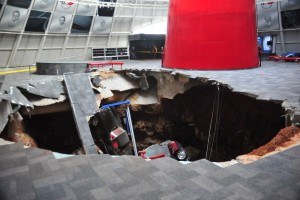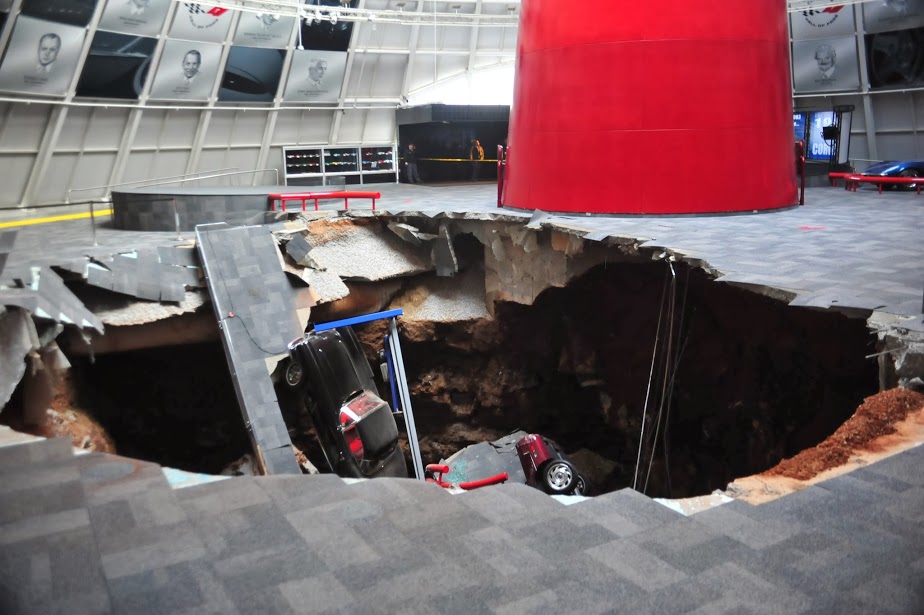The car-swallowing hole has been fixed but not forgotten at the National Corvette Museum in Kentucky. Yellow tape now marks the boundaries of the cavity that became a sensation and put the museum on the map. And instead of a gaping sinkhole driving tourism, now it’s the vintage sports cars crunched by rocks and dirt.
Work ended recently to fill in the pit that consumed eight prized sports cars in early 2014. The repaired exhibit area has become a magnet for visitors, and the dirt-caked remains of the mangled cars are the stars.

Where the 60-foot-long, 45-foot-wide, 30-foot-deep sinkhole once drew gasps from visitors, now it’s the remains of the worst-damaged cars that get astonished looks.
“It’s just horrifying,” said Corvette owner Doug Kidd, of Canton, Ohio. “Nature’s a pretty big thing to deal with. They look like they went through a tornado.”
Seven of the eight cars are back on display in about the same spot where they plunged to fame. Five were too beaten up for repairs. One is fixed, another will return Sept. 3 after being repaired in Michigan and another will be restored by the museum. The eight cars carried a total value believed to exceed $1 million.
The museum’s Facebook followers now exceed 200,000, compared to about 50,000 before the sinkhole opened. On social media, photos showcasing the damaged cars outpace those of the shiny, sleek models on display, said museum spokeswoman Katie Frassinelli.
“People just really enjoy hearing the story and like seeing the damage,” she said. “I guess it’s the rubberneck effect. These cars definitely appeal to a wider audience.”
In the gift shop, jars of sinkhole dirt and rocks fetch $10 apiece. Nearly 2,400 jars had sold through July.
Wanda Cohen of Roswell, Georgia, had just posted a photo of a wrecked car on her Facebook page.
“It’s like looking at the worst wrecks you’ve ever seen,” she said.
For museum officials, the trick is to keep the site’s popularity from going in reverse now that visitors can’t gawk at the sinkhole. The museum cashed in on the giant chasm with record attendance and revenue in 2014.
Last year, the museum just off the interstate drew 251,258 visitors, easily topping the 150, 462 visitors in 2013. The museum’s prior record attendance was 200,900 in 1999. Through last month, attendance for 2015 was off just 2.5 percent compared to the first seven months of 2014, the museum said.
“We just want to try to do our best to make sure the decrease is as little as possible,” museum Executive Director Wendell Strode said.
Maintaining that momentum will be challenging, said Jason Swanson, a University of Kentucky assistant professor in hospitality management and tourism. Even if the sinkhole had been left open, the publicity that helped spark the attendance bump would have eventually waned, he said.
“The museum is better off since more people now know of the museum because of the sinkhole’s publicity,” Swanson said. “However, 10 years down the road, 2014 and 2015 will likely be seen as an anomaly.”
The museum is doing its part to keep the sinkhole etched as a curiosity.
A temporary exhibit shows the now-famous security camera footage of the floor’s collapse and cars toppling like toys into the pit. That footage has been viewed about 8.5 million times on YouTube, the museum said. The hole opened up when the museum was closed, and no one was injured.
There’s also video of the damaged Corvettes being pulled from the hole. Also featured are condolence cards to the museum. One card-sender wrote of being “devastated to hear of your loss.”
A new sinkhole-themed exhibit is scheduled to open this fall.
Kidd said he wished at least part of the sinkhole had gone unplugged. It was an option discussed by museum leaders before they opted to fill it in.
“It’s human nature to come and see,” Kidd said.
Terry Jorgensen of Deland, Florida, said it would have been impractical to keep the hole open. Getting to see the crunched cars was more than enough, he said.
“I’m in awe of finally being here and seeing it,” he said.
The repairs began last fall and cost about $5 million, Frassinelli said. Insurance covered everything but the museum’s deductible. Donations picked up the deductible, she said.
Museum officials at first devastated by the chasm now have a much different attitude.
“We decided to embrace it,” Frassinelli said. “And what could have been a really big negative for the museum turned out to be a positive.”
Was this article valuable?
Here are more articles you may enjoy.


 Twice Injured Firefighter Loses Second Workers’ Compensation Claim
Twice Injured Firefighter Loses Second Workers’ Compensation Claim  Cat Bonds Linked to Wildfires Lose ‘Once Untouchable’ Status
Cat Bonds Linked to Wildfires Lose ‘Once Untouchable’ Status  Flooding in California Leads to Soaked Roads, Water Rescues and 1 Death
Flooding in California Leads to Soaked Roads, Water Rescues and 1 Death  Tesla Drivers Are Buying Escape Tools and Cars to Avoid Getting Trapped Inside
Tesla Drivers Are Buying Escape Tools and Cars to Avoid Getting Trapped Inside 